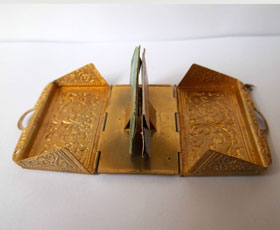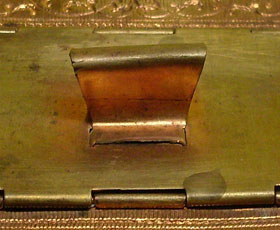Carpet Bag
Patent/design registration not found

Needle Case (photograph from eBay, now part of Lynda Herrod's collection)
Design Details
Needle Case Type: |
Figural |
Patent/Registered to: |
Unknown |
Patent/Design Representation #: |
Unknown |
Patent/Design Registration Date: |
Unknown |
Location of Patent/Design Registration: |
Unknown |
Reference #: |
Unknown |
Dimensions: |
5.5 x 3.6 4 |
Material: |
Brass |
Name Variations: |
W. Avery & Son - Redditch |
Other Variations: |
Different center clips |
Additional Photographs


Front and side (photos from eBay)


Bottom and signature detail (photos from eBay)


Latch/catch detail and side detail views (photos from eBay)


Interior detail showing different center clips (photos from eBay)


Interior detail showing different center clips (photos from eBay)


Interior close up view of different center clips (photos from eBay)

Detail of missing exterior latch/catch (photos from eBay)
Facts
The carpet bag is a travel bag which although often made from carpet or oriental rug material, could also be made from other heavy duty
material like tapestry or upholstery fabric, stretched over a supporting frame. They became popular in Europe and the USA in the 19th
century because they were practical, hard wearing, roomy, lockable and cheap. Some could even be opened out to make a rug to improve
comfort while travelling.

History
In the Victorian era, as affluence and leisure time increased, travel became more common for the middle classes and the carpet bag came
became popular. They were relatively inexpensive as they were made of recycled or offcut material. In the Victorian age, thrift was a
way of life. Unlike today clothing would be worn, even if handed on or down, until worn out, then the cloth reused or sold to the rag
and bone man. Rags were made into paper. Cooking pots were repaired if necessary, food scraps kept in wash buckets to feed pigs
and even house dust saved to be used in brickmaking. It is understandable then that carpet and tapestry would be reused for such a
practical purpose. Carpet bags are still in production today but more as a fashion item and of new materials. Younger people are
more likely to associate them with the popular fictional character Mary Poppins who travelled with a carpet bag.

Miscellaneous
A “carpetbagger” is a derogatory term used to describe a newly arrived opportunist. Its origins are traced to the Reconstruction
Period after the American War of Independence when Northerners moved to the South to take part in the reconstruction effort. Many of
these people carried carpet bags in the style of the day and although some were well intentioned, there was general mistrust of their motives
by Southerners who believed they came to profit at their expense. Today the name carpetbagger has been used to describe political
aspirants who are not from the area they seek to represent, trades people who move in to profit following natural disasters and those who move
in to make windfall profits from financial institutions.

Note: Right side panel text and photos provided by Lynda Herrod.





















